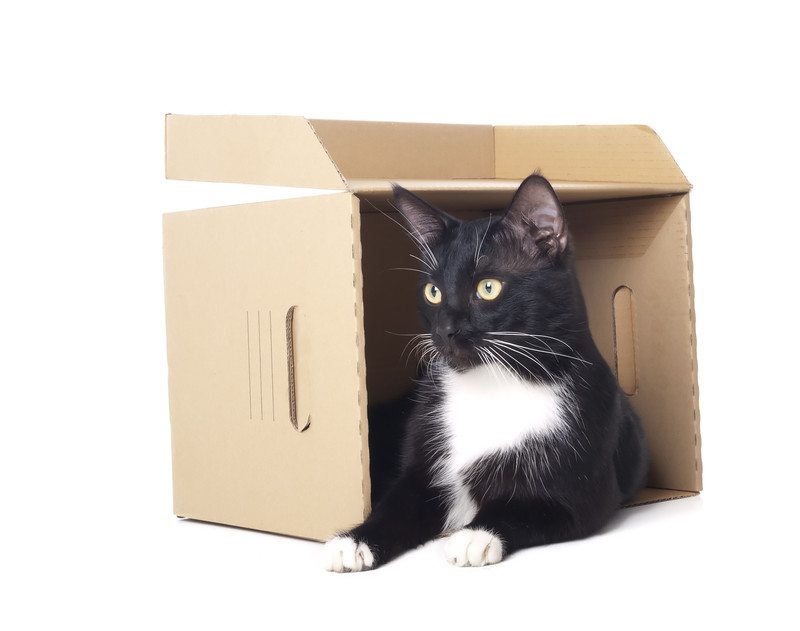
Cats do not like change, so you’re going to need some tips on moving to a new home with your cat. Cats are also territorial, which can also make this change scary for them. The cat can see this as taking away their current territory that they have worked so hard to claim, especially their favorite spots in the house. Moving is stressful for us, so you can imagine that it is also stressful for your cat who doesn’t fully understand what is going on.
Prepare Yourself for Your Cat’s Challenge
You first need to prepare yourself for the challenge your cat will give you. He’s not going to just move and be fine with it (this would be a rare case if it happened!). Expect your cat to behave differently be expressing his stress and disdain. He’ll show this with excessive meowing, hiding, some aggression, and attempts to escape in the hopes of returning to his original home.
Preparing Your Cat for the Move: 7 Steps
- Cat Carrier: Place your cat’s carrier in plain view with the door open. Leave some treats or catnip inside the cat carrier to show your cat that this is his. He’ll be more likely to check it out, and associate going inside it with good things (catnip and treats). You can also put his favorite blanket or bed inside the carrier. Use anything that will help him.
- Moving Boxes: Get the moving boxes out a few weeks before you have to pack to get ready to move. While cats love boxes, seeing that many boxes may overwhelm him.
- Packing: While packing your items keep a close eye on your cat. The noise and activity might be overwhelming for him. If it is close your cat in a room with his bed, food, water, and litter box while you’re packing.
- Routines: Stick to your cat’s daily routine of feeding and playing. Cats live by routines. Feed him at the normal times, and keep play time at the same time every day.
- Medication: Anti-anxiety medication is an option is your cat is showing high stress. Consult your veterinarian if you think he might need this.
- Vet Care: If you need to switch veterinarians get your cat’s records moved to the new location while you are preparing to move.
- Lost Cat File: Put together a lost cat file just in case he sneaks out during the move or after the move. We’ll talk about preventing this in the next section, but you can never be too careful or prepared. Have a good photo of your cat ready. Get a collar with your cat’s name, your phone number, and your address on it. This will help just in case your cat escapes during the move.
- Microchip: This is another option in case your cat escapes. Often a cat will return to your old home, but a microchip will help you find your cat no matter where he goes. Simply make an appointment with your veterinarian to have your cat microchipped. Too many cats escape and are never found. A microchip can change this. Microchips have radio-frequency identification (RFID) so that if your cat is found and sent to a shelter they can use a scanner to get the information needed to return your cat. It’s easy, about as painful as a vaccination, and affordable at about $45.
Moving with Your Cat
When getting your belongings out of the door you need to confine your cat to a room with his food, water, bed, and litter box to prevent him from running outside. If you have movers helping you put a sign on the door where your cat is alerting the movers to keep the door closed. Keep his carrier and a couple of empty boxes in there so he has some hiding places to help him feel more secure.
Prevent stomach upset and/or vomiting by feeding your cat a light breakfast on moving day.
While moving resist the urge to open the door on the cat carrier, even when he gives you those pleading eyes. He’s likely to dart out when scared. Only open the cat carrier door when it’s 100% safe to do so.
Take some emergency duct tape. If the cat carrier needs repairs you can slap some duct tape on in the meantime.
Settling Your Cat in the New Home
Don’t open the door to the carrier yet!
Time to cat proof your new home! This new home has to be safe for your cat. Keep him in the carrier while you check everything out. Look for any loose window screens, tight spots where he could get stuck, loose electrical cords, cat poisonous plants or flowers, and bug poison traps. Fix or remove these cat dangers.
Create a Safe Room
Dr. Jeff Werber, a Los Angeles veterinarian, has some advice about creating a safe room for your cat, “Cats are sensitive and are easily stressed. When moving to a new home, try to recreate—as completely as possible—a room that the cat was familiar with in your old home. This way, even though the location is different and might take some getting used to, there is a haven of the familiar.”
Choose a room dedicated to your cat – the safe room. Place your cat, still inside his carrier, his litter box, his food and water dishes, bed, and toys. Open the door to the cat carrier and let him come out when he is comfortable. Don’t force him out. He will wander out when he’s ready. The door to this room needs to be closed at all times. Keep him in this room for two to three days. After this time you can open the door and leave it open. Again, don’t force him out. He will come out in his own time. Praise him with treats when he does venture out.
Dr. Michael Santiago, D.V.M. of the East Orange Animal Hospital recommends using pheromone scents, “…pheromone scents that may help the cat acclimate and reduce anxiety.”
Once out of the room your cat will want to explore the house. Keep the safe room intact a bit longer so he has somewhere to run to if he needs to. If you want his items in a different location there are two things you can do. One is moving them toward the new location a little bit each day. The other is to have a second set of food and water dishes and a second litter box already in the new area. Then you can remove the first items when your cat is getting comfortable with the new home.
If you use these tips when moving to a new home with your cat you both will have a much easier and less stressful time. Happy moving!









